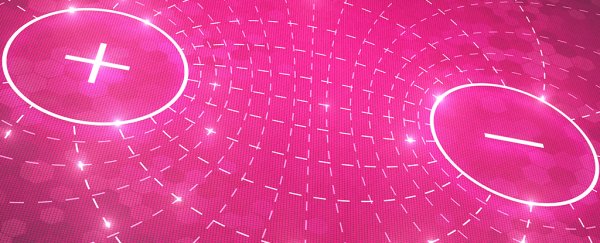More than eight decades after they were predicted to exist, physicists have found evidence of discrete units of matter that could help us better understand the electrical equivalent of ferromagnetism.
What does that mean? While some materials are permanent magnets that produce their own magnetic field, other materials, such as iron, are ferromagnets. They become attracted to magnets under the influence of a magnetic field.
Ferroelectrics, in theory, work in the same way. But it's the electrical component of an electromagnetic field, not the magnetic one, that changes them.
That doesn't sound too exciting, but unlocking the power of ferroelectrics could lead to advanced data storage technology that would allow us to fit a whole lot more on our devices.
It could also solve a long-standing mystery in physics, because up until now these particles had been hypothesised but never seen.
Called hysterons, they are nano-scaled stacks of molecules that act like independent particles in a crowd.
Researchers from Linköping University in Sweden and the Eindhoven University of Technology in The Netherlands found them when they analysed the way molecules in two different materials follow the rules of ferroelectrics.
To better understand ferroelectrics, let's go back to its twin, ferromagnetism. If you studied science, you might remember that a common classroom activity involves stroking a needle with a strong magnet to create a magnetic compass.
This works because the needle is made of a material such as iron or nickel, which has the right atomic properties for its particles to reconfigure under the magnetic aspect of an electromagnetic field.
Ferroelectrics is more or less the same thing, only the particles in these materials permanently transform into a new configuration under the pull of the electrical component of an electromagnetic field.
They're more or less two sides of the same coin, and come down to the way particles arrange themselves as units called dipoles.
In ferromagnetism we think of these as north and south poles. If we're talking about ferroelectric materials, we're looking at positive and negative poles.
Dipoles are usually randomly arranged, pointing every which way, which is why your packet of iron nails don't all stick together like a box of bar-magnets.
But under the coercion of a strong enough electrical or magnetic field, those individual poles collectively polarise and work together to build a cohesive field of their own.
The big question is what does 'strong enough' mean? Getting those dipoles to swing about depends on what forces are holding them in place; an effect referred to as hysteresis.
In an ideal world the entire chunk of a material would all demonstrate hysteresis in the same way.
But somebody forgot to tell nature, and on a small scale groups of molecules within the same chunk of material are affected by factors that force them to march to the beat of their own drum.
These patches of molecules are called domains when we're looking at north and south poles. In 1935, a physicist named Franz Preisach published his thoughts on the electrical equivalent, which he dubbed hysterons.
According to the Preisach model, individual hysterons should react to different field strengths as if they're discrete particles of matter, just like domains. That's a neat idea, but physicists until now haven't made a lot of progress filling in the details on the theory behind these units.
By comparing a pair of organic ferroelectric materials with unique structures, researchers have now identified molecule arrangements that resemble hypothetical hysterons.
While they have many differences, both materials contained nanometre-wide stacks of molecules a few nanometres in length.
"The trick is that they have different sizes and strongly interact with each other since they are so closely packed," says the study's lead researcher, Martijn Kemerink from Linköping University.
"Apart from its own unique size, each stack therefore feels a different environment of other stacks, which explains the Preisach distribution."
Since most ferroelectric materials are fairly similar, they had to work hard to find two that were different enough to whittle down the variables. Then there was the challenge of manipulating the molecular stacks to demonstrate they behaved just like hysterons.
"Now that we have shown how the molecules interact with each other on the nanometre scale, we can predict the shape of the hysteresis curve. This also explains why the phenomenon acts as it does," says Kemerink.
Many memory devices we rely on in computing rely on switching magnetic dipoles in ferromagnetic materials.
With better ways to model ferroelectric activity, researchers can now explore designs for devices that can cram in even more information into every unit.
This research was published in Nature Communications.
